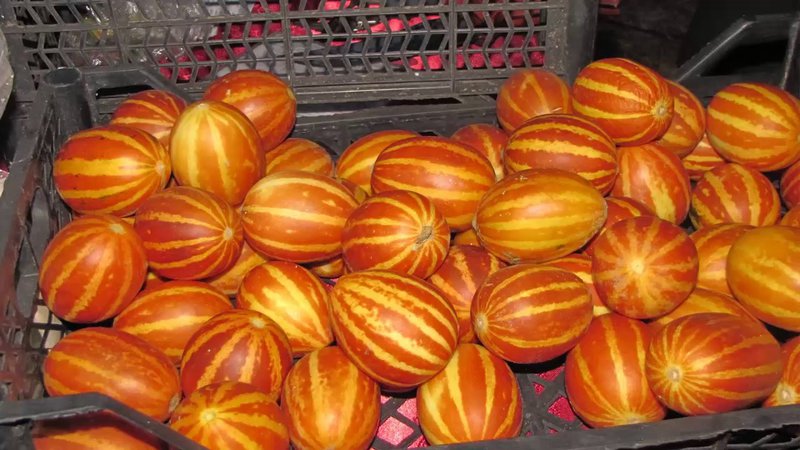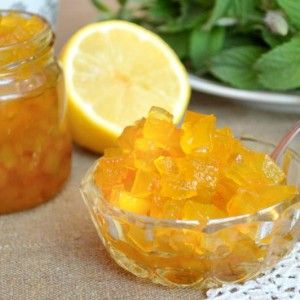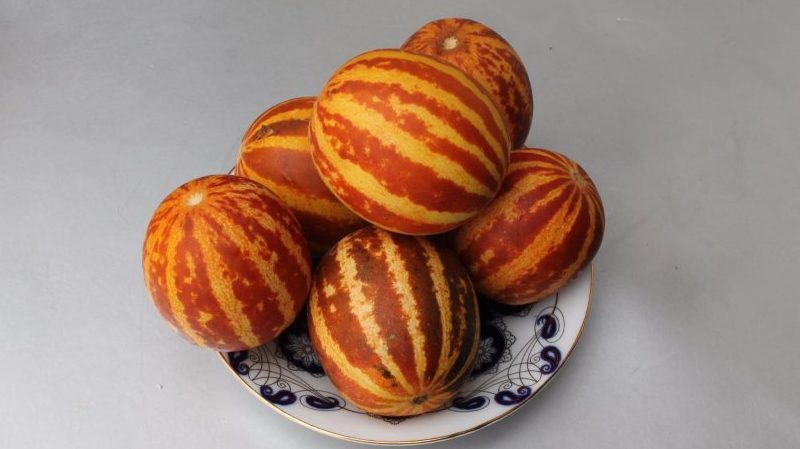An exotic fruit with an unusual appearance and interesting taste - Vietnamese melon
Early ripening Vietnamese melon is grown in regions with an unstable climate and cool summers - in the Urals or Siberia. Compact fruits have time to ripen in a few months; in August, summer residents harvest.
Vietnamese shows stable yields in open beds, greenhouses or greenhouses. Let's take a closer look at the process of growing a small striped melon.
The content of the article
Melon variety description
The heat-loving culture ripens in 80-90 days from the moment the first shoots appear. It is planted in seedlings.
Distinctive features
Fruits ripen in compact beds. Melons are small, so there is no need to tie up the plant. Vietnamese is suitable for growing in small beds. The main thing is that the land is fertile. The plant is immune to diseases and insect pests.
Composition and properties
 100 g contains only 34 kcal, so the melon is used to make diet sweets. The pulp of the fruit is also used for cosmetic purposes - masks, tonics and face lotions are prepared from it.
100 g contains only 34 kcal, so the melon is used to make diet sweets. The pulp of the fruit is also used for cosmetic purposes - masks, tonics and face lotions are prepared from it.
Melon juice smoothes fine wrinkles, makes the skin radiant and elastic.
The product contains:
- vitamins group B, which are essential for eye health;
- vitamin C, which strengthens the immune system and has an antiviral effect;
- dietary fiber that activates digestion and metabolic processes.
The product also contains calcium, phosphorus and iron.
Fruit characteristics and yield
Round melons have a smooth, striped skin. Their color is yellow-brown. Fruit weight varies from 100 to 200 g. The pulp is orange, milky, sweet and honey. Summer residents remove up to 15 fruits from one bush.
How to choose fruits when buying
Vietnamese is rarely found on store shelves, most often it is bought from gardeners in the market. Ripe melons have a pleasant aroma, firm thick rind and dry stalk.
There should be no scratches or cracks on the seed surface. If the melon is soft, then it is overripe.
Important! It is not recommended to buy melon off the road or on the highway. Exhaust fumes from cars negatively affect the taste and quality of the fruit.
How to grow a variety yourself
Melon cultivation requires basic knowledge and skills. Vietnamese melon is grown by seedlings. Seedling material is prepared at the end of March. Let's take a closer look at what is needed for this.

Planting and growing seedlings
Seedlings require seeds, seedling containers and soil. They buy all this in specialized stores or use improvised means.
When growing seedlings, follow these guidelines:
- For planting, select large seeds: they need to be disinfected with a solution of Bordeaux liquid.
- Soak the seeds in warm water for a day with the addition of a growth stimulant. The seeds will swell, the stimulant will strengthen their immunity.
- Freeze the material by placing the seeds in it for 10 hours.
Peat tablets or pots, cardboard boxes, flower pots are used as containers. The container is washed with soda, filled with earth. The depth of the landing pits is at least 1 cm.
Place 2 seeds in each, cover with earth and slap. Immediately after that, pour plenty of warm water.The next time the seedlings are watered only after 6 days.
Important! For melons, use a mixture of soil from the garden and soil from the store. They take equal parts, add peat, humus and river sand to them as a natural baking powder. The soil is placed in a freezer for a day - low temperatures destroy larvae and microbes.
Planting and caring for a melon
Seedlings are planted in May after the last spring frosts. The best precursors for Vietnamese are cabbage, legumes, onions, herbs, potatoes, or peppers. It is not recommended to plant a melon after melon crops - watermelons, pumpkins or other melon varieties.
 The beds are dug up with a shovel, they are cleaned of foliage and debris, large clods of earth are broken. Vietnamese landing pattern - 70x70. Seedlings are carefully moved into the holes, sprinkled with earth. The bushes are covered with foil until the first three leaves appear.
The beds are dug up with a shovel, they are cleaned of foliage and debris, large clods of earth are broken. Vietnamese landing pattern - 70x70. Seedlings are carefully moved into the holes, sprinkled with earth. The bushes are covered with foil until the first three leaves appear.
Water the melon as the soil dries. Use water previously heated in the sun. Once every two weeks, instead of water, they use nettle infusion or Bordeaux liquid - they improve the taste of the fruit and strengthen the immune system.
Two weeks after planting, the first feeding is organized. Saltpeter, superphosphate, the Magic Watering or Zdraven 'mineral complex are added to the beds. The interval between dressings should be at least 15 days.
Important! Manure, humus, compost, and bird droppings are used as organic fertilizers. Thanks to organics, shoots and leaves become healthy and strong. They introduce food after watering.
Features of cultivation and possible difficulties
Before each watering, the soil is loosened. The procedure saturates the earth with oxygen, which has a positive effect on the development of the root system.
After loosening, the bushes are sprinkled and sprinkled with peat chips. As soon as 5 ovaries are formed on one stem, pinch the top of the plant. Pinching will speed up the ripening time, the fruits will grow large and sweet.
Pay close attention to the amount of mineral fertilizers. Nutrition should be balanced. Lack or overabundance of elements leads to disease and drying out.
Melon Vietnamese are needed:
- Nitrogen - stimulates the growth and development of plants. When it is deficient, the plant withers.
- Potassium - protects the melon from diseases and pests, strengthens the immune system, participates in the setting and formation of fruits. An excess of potassium leads to yellowing of the leaves.
- Phosphorus - strengthens the roots and nourishes them. Due to the lack of phosphorus, the melon gets sick with root rot.
Diseases and pests characteristic of the variety
Of the diseases, tobacco mosaic is noted. It appears as a yellow pattern on the leaves. The virus disrupts metabolic processes, slows down the development of ovaries and fruits. Appears both on young seedlings and on adult plants during fruiting.
The cause of the disease is contaminated soil, sudden temperature changes, improper watering. As a preventive measure, the bushes are sprayed with a solution of iodine or onion peel. For treatment, use the drug "Quadris" or "Maxim".
Another disease is fusarium wilting. Reasons for the appearance: an excess of mineral fertilizers or non-observance of the rules of crop rotation. The plant becomes covered with a gray bloom, the fruits lose their taste and are deformed. For prophylaxis, spraying with Bordeaux liquid or HOM preparation is used.
Important! Melon fly or melon aphid like to feast on melon. Small midges suck nutritious juice from the leaves, the bushes do not have enough strength to develop. They get rid of pests with the help of Iskra or Maxim preparations.
Harvesting and application of the crop

The ripeness of Vietnamese is determined by the honey aroma and hard peel. Fruits should be firm and dry. Ripe melon makes a dull sound when struck lightly. An early-ripe variety is not suitable for storage, the fruits are consumed immediately after collection.
Melon is used to make smoothies jam, jelly.Its taste is harmoniously combined with other fruits and berries - watermelon, pear, bananas, apples.
Vietnamese is also used for preparing salads and side dishes. The hostesses prepare a salad with chicken fillet, melon pulp and avocado, or make the famous Italian appetizer with melon and Parma ham.
Interesting... Roasted melon seeds are a common snack in African cuisine.
Advantages and disadvantages of the variety
The advantages include the original appearance of the fruit - round striped balls look beautiful both on the beds and on the dining table. Compact melons are convenient to take with you - for example, for a visit or for a picnic.
The pulp is juicy and sweet, suitable for individual consumption and for making fruit salads, pastries, snacks. The variety is cold-resistant, unpretentious in care. It is successfully cultivated both in the southern and northern regions.
Of the shortcomings, the short shelf life of the fruits is noted. The crop is consumed or processed immediately after harvest. The maximum term is no more than one week.
Reviews

Some summer residents love Vietnamese for small fruits, others - for unpretentious cultivation. However, some gardeners were disappointed in this variety.
Maria, Perm: “I recommend Vietnamese for landing to everyone! Beautiful and tasty fruits grow quickly, do not get sick. We eat melons with the whole family - the taste is soft, sweet. "
Pavel, Moscow region: “I'm planting Vietnamese for the second season in a row. I use the seedling method, during the growing season I feed with manure. The variety is not bad, it bears fruit stably. The taste is pleasant, the aroma is honey. "
Anastasia, Ufa: “I planted a Vietnamese one for the first time. I planted it with seeds in open ground, which is probably why the plants did not tie well. Also, frosts hit, so the harvest turned out to be meager. I will grow more resistant varieties. "
Read also:
Review of the sweet and juicy variety of melon "Slavia".
Ways to cook dried melon at home.
Is it possible to freeze melon and how to do it in different ways.
Conclusion
The green and yellow fruits of the striped melon are loved by gardeners all over the country. They have an attractive decorative appearance; the treat is used in the preparation of various dishes.
Breeding begins with the preparation of seedlings. After planting in the garden, melons are watered with warm water as the soil dries. Organic and mineral fertilizers, timely formation of a bush, and loosening of the beds help to get the harvest.